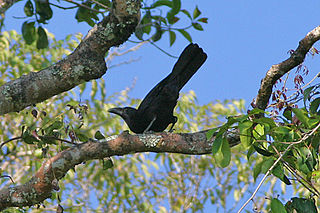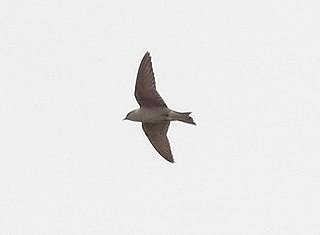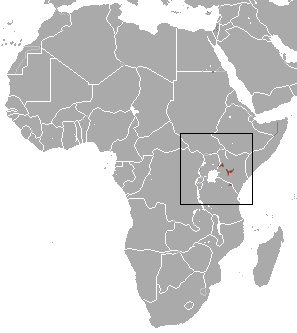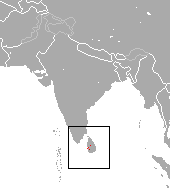Ptychadena retropunctata is a species of frog in the family Ptychadenidae. It is found in Guinea, Liberia, Sierra Leone, and possibly Ivory Coast. Its natural habitats are moist savanna, subtropical or tropical seasonally wet or flooded lowland grassland, subtropical or tropical high-altitude grassland, and intermittent freshwater marshes. It is threatened by habitat loss.

The Flores crow is a species of bird in the family Corvidae. It is endemic to Indonesia.

The Peruvian martin is a species of bird in the family Hirundinidae. It is found in Peru and far northern Chile.

The montane white-toothed shrew is a species of mammal in the family Soricidae. It is found in Kenya, South Sudan, Tanzania, and Uganda. Its natural habitats are subtropical or tropical moist montane forest and subtropical or tropical seasonally wet or flooded lowland grassland. It is threatened by habitat loss.

The jungle shrew is a species of mammal in the family Soricidae endemic to Sri Lanka. Its natural habitat is subtropical or tropical dry forests. It is threatened by habitat loss.

The Bioko forest shrew or Isabella's shrew is a species of mammal in the family Soricidae found in Cameroon and Equatorial Guinea. Its natural habitats are subtropical or tropical moist montane forest and subtropical or tropical high-elevation grassland.

The Nicobar flying fox is a species of flying fox in the family Pteropodidae. It is endemic to India. Its natural habitats are subtropical or tropical moist lowland forest and subtropical or tropical swamps. It is threatened by habitat loss due to forest clearing.
Bulimulus darwini is a species of tropical air-breathing land snail, a pulmonate gastropod mollusk in the subfamily Bulimulinae.
Bulimulus jacobi is a species of tropical air-breathing land snail, a pulmonate gastropod mollusk in the subfamily Bulimulinae.
Bulimulus lycodus is a species of tropical air-breathing land snail, a pulmonate gastropod mollusk in the subfamily Bulimulinae.
Phlegmariurus ascendens is a species of plant in the family Lycopodiaceae. It is endemic to Ecuador. Its natural habitat is subtropical or tropical high-altitude grassland. It is threatened by habitat loss.
Phlegmariurus austroecuadoricus is a species of plant in the family Lycopodiaceae. It is endemic to Ecuador. Its natural habitats are subtropical or tropical moist montane forest and subtropical or tropical high-altitude grassland. It is threatened by habitat loss.
Phlegmariurus columnaris is a species of plant in the family Lycopodiaceae. It is endemic to Ecuador.
Phlegmariurus cumingii is a species of plant in the family Lycopodiaceae. It is endemic to Ecuador. Its natural habitats are subtropical or tropical moist montane forest and subtropical or tropical high-altitude grassland.
Phlegmariurus espinosanus is a species of plant in the family Lycopodiaceae. It is endemic to Ecuador. Its natural habitat is subtropical or tropical high-altitude grassland. It is threatened by habitat loss.
Phlegmariurus llanganatensis is a species of plant in the family Lycopodiaceae. It is endemic to Ecuador. Its natural habitat is subtropical or tropical high-altitude grassland. It is threatened by habitat loss.
Phlegmariurus loxensis is a species of plant in the family Lycopodiaceae. It is endemic to Ecuador, where it occurs in the páramo and forests of the Andes. It is threatened by fire in its habitat.
Phlegmariurus scabridus is a species of plant in the family Lycopodiaceae. It is endemic to Ecuador. Its natural habitats are subtropical or tropical moist montane forest and subtropical or tropical high-altitude grassland. It is threatened by habitat loss.
Phlegmariurus talpiphilus is a species of plant in the family Lycopodiaceae. It is endemic to Ecuador. Its natural habitat is subtropical or tropical high-altitude grassland. It is threatened by habitat loss.
Phlegmariurus nutans, synonym Huperzia nutans, known as wawaeʻiole or nodding clubmoss, is a species of club moss in the family Lycopodiaceae. It is endemic to wet forests and cliffside shrublands on the islands of Oahu and Kauai in Hawaii. It is threatened by habitat loss.






